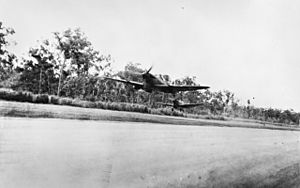Raid on Darwin (2 May 1943) facts for kids
Quick facts for kids Japanese raid on Darwin (2 May 1943) |
|||||||
|---|---|---|---|---|---|---|---|
| Part of the Pacific War | |||||||
 Two Spitfires taking off from an airstrip near Darwin in March 1943 |
|||||||
|
|||||||
| Belligerents | |||||||
| Commanders and leaders | |||||||
| Strength | |||||||
| 27 Zero fighters 25 bombers |
33 Spitfire fighters Darwin anti-aircraft guns |
||||||
| Casualties and losses | |||||||
| 6-10 aircraft destroyed 8 aircraft damaged |
2 pilots killed 1 soldier killed 14 Spitfires destroyed or damaged Minor damage to buildings |
||||||
The Japanese raid on Darwin of 2 May 1943 was an important air battle during World War II. It happened in the North Western Area Campaign, which was a part of the larger Pacific War. On this day, more than 20 Japanese bombers and Zero fighters attacked the Australian town of Darwin, Northern Territory.
Even though many planes attacked, they caused only a little damage on the ground. This attack was the 54th time Japanese planes had bombed Australia. The Royal Australian Air Force (RAAF) had a special group, No. 1 Wing RAAF, that was supposed to protect Darwin. They met the Japanese planes after the attack was mostly over. The RAAF planes had a tough time and lost many aircraft. This was made worse because some planes ran low on fuel.
The outcome of this battle worried the public. Because of this, No. 1 Wing RAAF changed how they fought. These new methods worked well against future Japanese air raids.
Contents
What Happened During the Raid?
On May 2, 1943, Japanese planes flew towards Darwin. They wanted to bomb the town and its military bases. The attack involved many different types of aircraft. These included powerful bombers and fast Zero fighter planes.
The goal of the Japanese was to weaken Australia's defenses. They hoped to stop the Allies from using Darwin as a base. Darwin was a key location for supplies and troops.
The Attack Begins
The Japanese planes arrived over Darwin. They started dropping bombs on different targets. These targets included the harbor and airfields. They also aimed for buildings in the town.
However, the bombs did not cause much harm. The damage to buildings was small. The military bases were not badly hit either. This was good news for Australia.
Australian Defenders Respond
The Royal Australian Air Force (RAAF) had Spitfire fighter planes ready. These planes belonged to No. 1 Wing RAAF. Their job was to protect Darwin from air attacks.
When the Japanese planes were leaving, the Spitfires took off. They tried to stop the Japanese. A big air fight happened in the sky.
Air Combat Over Darwin
During the fight, the RAAF Spitfires faced the Japanese Zero fighters. The Zeroes were very fast and agile. The Spitfires tried their best to shoot down the enemy planes.
Sadly, the RAAF lost many planes. About 14 Spitfires were either destroyed or damaged. Two Australian pilots also died during this battle. One soldier on the ground was also killed. The Japanese lost some planes too, with 6 to 10 aircraft destroyed.
Why Was This Raid Important?
The raid on Darwin on May 2, 1943, showed a few things. It showed that air attacks were still a threat to Australia. It also showed that the RAAF needed to improve its tactics.
Public Concern and New Tactics
After the raid, people in Australia were worried. They wanted to know why so many Spitfires were lost. The government and military listened to these concerns.
No. 1 Wing RAAF decided to change how they fought. They learned from this battle. They developed new ways to intercept and fight enemy planes. These new tactics helped them protect Darwin better in later raids.
The raid was a tough lesson. But it helped the RAAF become stronger. It made them better prepared for future attacks during World War II.

